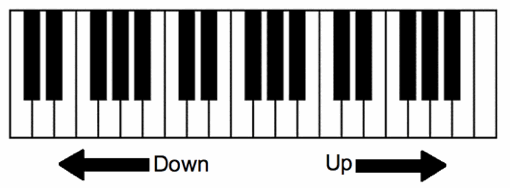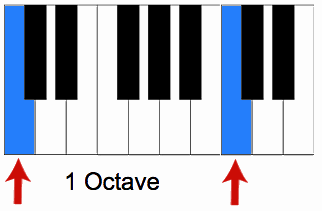The layout piano keys is actually a lot easier than it appears. When beginners look at the piano keyboard its easy to get intimidate. The piano is just a repeating pattern of notes that goes up and down the keyboard.
Once you learn the trick to the pattern you will easily know every note on the piano keyboard. Here we will discuss how easy it is to learn every key on the piano in a matter of minutes.
High Notes Versus Low Note
Before we can even start learning the layout piano keys we have to understand how the notes on the piano work.
The piano keyboard keys are laid out with the lower pitch notes to the left and the higher pitch notes to the right. So, if you play the note farthest to the left you will hear the lowest note the piano is capable of playing and then to the right the highest note on the piano.

Take a look at the image above and you will see that as you get further to the left the notes are lower and to the right they are higher in pitch.
This is important because as you start to learn to read music and play by ear you will be able to easily know in which direction to go to make a lower or a higher pitch note.
Number of Keys on the Piano Keyboard
The piano is one of the most diverse instruments there are. It is capable of playing a wide range of notes and pitches on a single instrument.
Even though there are a wide range of notes, most piano players say within the center part of the piano, close to Middle C. (More on Middle C later)
There are 88 keys on a full standard piano. Some keyboard or synthesizers will have less then that. Digital pianos generally have a full 88 key range.
Whichever you have makes no difference. Whether you have a full piano or digital piano, or a 61 key synth you can still learn the pattern and the layout piano keys.
White Keys and Black Keys
On the piano keyboard you will notice that there are two different types of keys; white keys and black keys.
The white keys on the piano are known as naturals and are longer. The black keys are known as sharps and flats. These keys are shorter and skinnier than the white keys and there are fewer of these than the white keys.
These black keys are what you are going to use to help you identify the notes on the piano. So let’s get started.
Finding The Pattern
Let’s look at the image below of the piano keyboard. I know what you are thinking, “How in the world am I going to remember all of these keys?” Its actually very easy. Study the image and see if you can find a pattern.

If you look at the black keys they follow a pattern of a set of two and then a set of three. All the way up and down the piano you will notice this pattern repeats over and over again.
Look at the images and the layout piano keys and you will see the pattern of two and three.


Finding C and Middle C
Now that you have found the the pattern of black keys you can now easily learn the layout piano keys.
Find any two black note that are together, now move one note directly to the left.(This is known as a semitone, or half step)
This note is known as C. Now that you know where C is, you can label all the C notes on the piano keyboard. Look up and down the piano and find any set of two black notes that are together and find all of the C’s on the keyboard.
Middle C
Now that you know where all the C notes are on the piano keyboard we need to label Middle C. Middle C is important because this is where the separation between the treble clef and bass clef takes place.
This is also where you usually separate which hand plays which notes. If the key is below Middle C then you usually use the left hand, and if it is above Middle C then you usually use the right hand. This is not always the case but most of the time it holds true.
To find Middle C on a piano, you need to find the center of the piano. This is usually where the brand name of the piano or keyboard is. (If your synthesizer doesn’t have a brand name in the middle then you will just have to find the C closest to the middle.)
Once you have found the brand name, you can easily find the set of two black notes and find the C. This is Middle C!

Octaves on the Piano

Remember when we learned how the C notes repeated over and over again up the piano keyboard? This repeat of notes from one C to the next is know as an octave. An octave is simply the distance from note, to the next of the same pitch. So, moving from Middle C up to the next C from it would make an octave. You can also move down octaves. Going from Middle C to the C below it would be moving down one octave.
Octaves are important because it shows us how the layout piano keys repeats itself throughout the piano keyboard.
Piano Note Pattern
Now that we can find C and know what an octave is, it is time to learn the rest of the pattern.
If you look at the close up of the set of keys you will see that there are 12 keys. There are seven white keys and five black keys.
Piano Note Pattern
Now that we can find C and know what an octave is, it is time to learn the rest of the pattern.
If you look at the close up of the set of keys you will see that there are 12 keys. There are seven white keys and five black keys.

This set of keys is a group of notes that repeats itself throughout the piano keyboard. Look at the image below and you will see how this set of note repeats itself over and over again.
These 12 keys are the base notes for the layout piano keys. Once you learn these you can easily learn every note on the piano keyboard.
Now that you know the piano key layout, you need to learn the piano notes. Click here to learn the notes on the piano using this pattern!
Go From Layout Piano Keys Back to Piano Theory
Back to Home Page
